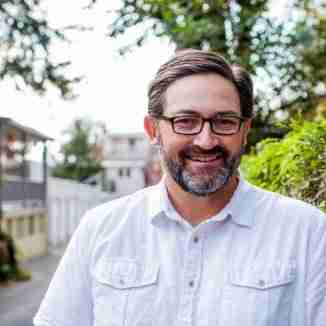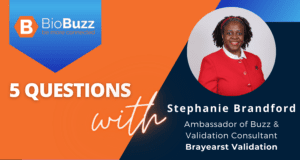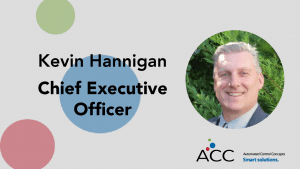
In Conversation with Ariel Weinberger, Founder, and CEO of Autonomous Therapeutics, Inc.
Rockville, Maryland’s Autonomous Therapeutics (Autonomous) is a rapidly expanding biotech developing the next generation of antivirals and therapeutics. Founded four years ago in New York City by University of Maryland alum and Harvard-trained scientist, Ariel Weinberger, the company has expanded into an 18,000 square foot facility in Rockville, where it is growing its scientific and leadership team to support its pipeline of first-in-class therapeutics aimed at ending viral pandemics.
Autonomous is developing what may be the first pan-genus antivirals to provide resistance-proof protection against any coronavirus or influenza strain (including future viral mutants that may evade vaccines). The company is backed by a growing list of private and U.S. government funders, from the Defense Advanced Research Projects Agency (DARPA) to a new partnership between BARDA and Johnson & Johnson known as Blue Knight.
It’s an exciting time for Autonomous, so we thought it was a great opportunity to catch up with Weinberger to learn about the company’s history, what it’s working on, and where the company is headed.
What is your company’s founding story? How did it all begin?
I was an academic researcher working with collaborators developing new mathematical models of viral evolution and drug resistance. But after probing the evolution of antiviral drug resistance for the better part of a decade, we had a theory about how we might solve the resistance problem. We thought we could develop the first therapeutics that evolved just like the viral diseases we needed to control.
At the time, we were focused on HIV, which is a chronic, decade-long infection. But we started the company to develop resistance-proof antivirals against acute respiratory viruses, which we and others knew were far more likely to cause large-scale pandemics. So, with little more than an idea and early data from HIV, we set out to develop antivirals against respiratory viruses like influenza. That was Day 0.
In a sense, our inexperience may have been helpful. Since we weren’t serial entrepreneurs, we had no concept of how hard and expensive starting from scratch would be. We also lacked experienced partners who might have driven us away from respiratory antivirals at a pre-COVID time when they weren’t yet popular. And we chose not to listen to the experienced advisors who wanted us to pivot to orphan conditions at the expense of pandemic threats.
Instead, we followed our passions and took a non-traditional route to building Autonomous. We took the 1980s garage-style approach—starting with a single bench in an incubator and zero dollars in the bank and spent a lot of nights failing at our initial ideas until we started getting exciting results.
The hard work aside, we could not have taken off without support from forward-thinking scientists at DARPA. They weren’t deterred by the fact that we lacked the prestige or clout of a university; they were intrigued by our passion and ideas and they invested in us early on. It is never easy to raise non-dilutive funding as a new company, so it did take a lot of pitches and small-scale proof-of-concept studies, but DARPA’s willingness to believe in small businesses like ours and in yet-unproven technologies is a key reason that we have been able to take off.
It also helped that we were able to recruit extremely talented scientists, who joined us based on little more than a problem and a cool idea about how to potentially solve it.
Tell me a bit more about the idea of developing evolving antivirals?
Sure, it made sense for HIV, but it turned out to be a poor approach for acute respiratory viruses, where there is no time for an antiviral to shape-shift into the right form. The patient could be dead by the time the therapy evolves into the right conformation.
Fortunately, after two years of trying and failing, we discovered a better approach. We realized that we could develop pan-genus antivirals that would work against any influenza variant without any need for therapeutic mutation or co-evolution. We then started doing the same thing for coronaviruses (well before the COVID-19 pandemic) and realized that we had a repeatable, platform approach to developing resistance-proof antivirals that could work against any respiratory viral infection. Ultimately, we pivoted from designing evolving antivirals to developing broad-spectrum antivirals—and that has been the foundation of our company since.
In retrospect, the problem of viral evolution ended up being far more foundational for us than our initial proposed technology. That focus on the problem rather than on a preconceived solution is actually something we gained from our academic backgrounds. I think good scientists are problem and question-driven, so our company maintains a culture of problem-driven science. Every one of our scientists, from Technician to Director, presents his or her work in a way that really explains the problem driving their current work, before they dive into potential solutions or new results. Sometimes that means giving up on a cool research direction, if it isn’t impactful to the problems at hand.
Tell me about ATI’s pan-genus antiviral technology? What is novel about it and how will it make an impact with viruses like coronavirus or influenza?
We always knew that the fundamental limitation of existing prophylactics and vaccines was a lack of broad-spectrum efficacy. That’s why you need a new flu vaccine each year. Similarly, if current vaccine approaches are the only COVID prophylactics developed, we could spend billions in R&D and trillions in economic costs—and end up right back in the current crisis when the next coronavirus emerges or if COVID-19 sufficiently mutates.
In contrast to the limits of current antivirals, a key reason that antibiotics have been so game-changing since the mid-twentieth century is their broad-spectrum efficacy. Our goal has been to make antivirals that are as broadly effective as antibiotics are.
But how do you do that? After all, viruses mutate orders of magnitude more quickly than bacteria. And we aren’t the first to try to build pan-genus countermeasures; others had been trying to develop universal influenza and HIV vaccines for decades to no avail.
Our key innovation was to develop prophylactics that are not vaccine or antibody-based. The problem with immune-based prophylactics is that they’re designed to specifically bind and neutralize specific viral surface proteins, like the coronavirus spike protein. Yet, these viral proteins evolve rapidly, leading to a loss of therapeutic binding and, ultimately, to drug resistance.
Instead of targeting these variable viral proteins, our idea was simple: engineer antivirals out of the conserved genetic elements that are shared across a viral genus—essentially using the shared genetic architecture of diverse viruses as the chassis for pan-genus antivirals. It sounds sci-fi and unachievable but we demonstrated, first using influenza, that the idea could work. We developed a single biologic with prophylactic efficacy against any Influenza A strain.
What about coronaviruses; how did you come to focus on those and how could your technology prevent the next pandemic?
Armed with the influenza data, we started working on coronaviruses six months before COVID-19 hit. We were motivated by a clear problem that extends well beyond the current COVID-19 pandemic.
Since 2003, there have already been two distinct and highly deadly coronavirus epidemics (SARS and MERS). These viruses were extremely divergent; over 50% of their genomes differed, despite being in the same ‘beta-coronavirus’ genus. The question was whether we could develop a single antiviral for both MERS and SARS, and by extension, for whatever random beta-coronavirus would emerge next.
Of course, no one expected that the next beta-coronavirus would seed a pandemic; the best guess at the time was that another deadly, localized epidemic would emerge that we wanted to have a countermeasure ready and FDA-approved against. SARS-CoV-2 came too early, but our aim is to have a pan-coronavirus countermeasure ready and stockpiled next time. Beyond ending COVID-19, the aim is to assure that effective antivirals are developed before the next pandemic emerges, so that we never again have to wait 12-18 months for life-saving countermeasures.
What has ATI’s collaboration with JLABS and ‘Blue Knight’ done for you and your company?
Johnson & Johnson (J&J) and its cutting-edge incubator, JLABS, have been great. JLABS is a unique program and we were fortunate to join JLABS shortly after its founding in New York City. JLABS has a very flexible arrangement that allows you to expand your footprint quickly, so we started with just a couple benches and within one year grew to multiple labs. Eventually, we got to the point where we had to expand into our own 18,000 square foot facility here in Rockville. To me, that’s the epitome of an incubator, where a company can grow at its own pace until it gains independence.
Beyond the space, a real benefit of JLABS was the mentorship and exposure to downstream thinking and regulatory expertise that we just didn’t have at the time. Our mentors asked a lot of tough questions about issues such as therapeutic delivery from the onset, at a time when we were still focused on designing the basic therapeutics that worked in cell culture. It was important for us to think about these downstream problems, because, for example, you don’t want to develop a therapeutic that can’t possibly be delivered. So, in addition to giving us the space we needed to grow, J&J also pushed us to consider downstream clinical questions as well as the upstream R&D.
They also encouraged us to apply to the new Blue Knight Program. The Blue Knight Program, which is a J&J Innovation/JLABS and BARDA partnership, is aimed at giving BARDA access to companies that can impact national security and public health security earlier than BARDA would normally step in. Before Blue Knight, BARDA traditionally would engage companies in Phase II and beyond, but many companies can flounder in that ‘valley of death’ long before Phase II even with innovative and impactful technologies.
The life science startup companies in Blue Knight are all pre-clinical. Blue Knight has been a great opportunity for us to be mentored, to gain exposure, and to gain funding from one of the government’s pre-eminent biomedical countermeasure agencies.
Given the fundamental challenges to developing countermeasures against the next threats, you can’t entirely wait until things are far down the clinical pipeline. If you want to nurture and accelerate game-changing ideas you need to fund them early and to ultimately take risks. Blue Knight allows BARDA to place early bets on promising ideas that have the potential to radically improve global public health security.
How did you first get turned on to Montgomery County as a potential location for Autonomous?
We founded the company in New York City, but I grew up in Maryland, so opening our facility here felt like coming home. There were a number of key attributes that made the D.C. area the right spot for us.
First and foremost, there is a tremendous pool of talent in the region, from government agencies and the biotech corridor all the way up to Frederick and Baltimore. As a company, our prime goal was to go where we could find the best talent to grow the company and where we felt our current employees would be comfortable laying down roots. So we didn’t necessarily want a flashy location like Cambridge. We had always taken a path less traveled, and we saw great opportunity in the D.C. area.
Beyond the talent, proximity to U.S. government agencies was key, since we collaborate closely with multiple government agencies on antiviral development. I used to be on Amtrak from New York to D.C. almost weekly. It’s certainly easier to collaborate when you’re close by.
The area is also welcoming, collaborative, and really helpful. You get the sense that the region wants companies to succeed here and is willing to invest to help make that possible. In particular, Montgomery County and the City of Rockville have been extremely supportive, and that has made a huge difference for us in our being able to get off the ground so quickly. Because of their help, we were able to identify a lab site, negotiate a long-term lease, and have a lab renovated, up, and fully functional in 2 months, all in the middle of COVID.
What are the next milestones for your company?
Our milestones are pretty straightforward.
We need to get into the clinic and to demonstrate the safety and pan-genus efficacy of our antivirals in clinical trials. There are many sub-milestones along the way as well, but those are the key goals. De-risking our technologies in early-stage clinical trials will provide the key validation for later-stage investment and development.
You plan to grow to 50 people in the coming three years. What type of people will you need to hire?
We always aim to bring new talent and ideas onboard, and this is even more essential as we make the leap toward the clinic. We hire talent across multiple functions, from discovery scientists who work on ‘Skunk Works’ like projects to experienced product managers who can help transition lead candidates through IND-enabling and clinical studies.
We’re not a single product company; we have a number of platforms, including robotic technologies that we engineer in-house. As a result, we hire more for talent and fit rather than a specific skill.
More broadly, we’re looking for creative scientists who have either invented something that hasn’t existed before or who have rescued a technology from a really difficult point of stoppage. We’re looking for people who understand the grit, creativity, and perseverance required to build something from the ground up.
In a sense, we want entrepreneurial scientists. To me, entrepreneurial doesn’t necessarily mean you started a company; being entrepreneurial might also mean that you worked doggedly and creatively to solve a significant problem and that, if necessary, you did it with minimal resources.
What message do you have for future employees about why Autonomous is a great place to work?
We are a place that will give you the opportunity to work on important problems that could save lives. And you’ll get the chance to do so irrespective of whether the problem is hot or still under the radar—because we believe in being ahead of the curve, and on working on the next threat.
You’ll also get a chance to innovate without bureaucracy or layers of lawyers or HR professionals standing in your way. We’re small and lean; we’re a tech startup at heart, but we work on biology. If you’re motivated by major public health problems and if you have the ability and perseverance to develop novel therapeutic solutions, get in touch. Or, if you want your career to merge business and science, well, we think the best business people are those who work on, understand, and drive the science.
What is the biggest lesson you’ve learned since becoming an entrepreneur/CEO?
A lot of experts will give you advice early on. Don’t treat it as canon. In my case, I was a mathematical modeler. Ignoring some of the advice which suggested I keep working on what I knew best and, instead, going with my gut ended being best for me.
More generally, the advice you receive from mentors is often based on the way things are traditionally done. This type of advice seems safe but, sometimes, the advice is a little too safe. You don’t want to wall yourself off from opportunities or your passions, because ultimately no path is safe, irrespective of what you’re told.
So I’d recommend that you really challenge the advice you get early on, whether internally or directly, if you’re close enough with the person. Clearly, you need advice and everyone needs mentors, but stay focused on the best possible way to move your goals and passions forward.
So keep pushing and send us an application if you’re awesome and ready to make a difference!
- About the Author
- Latest Posts
Steve brings nearly twenty years of experience in marketing and content creation to the WorkForce Genetics team. He loves writing engaging content and working with partners, companies, and individuals to share their unique stories and showcase their work. Steve holds a BA in English from Providence College and an MA in American Literature from Montclair State University. He lives in Frederick, Maryland with his wife, two sons, and the family dog.





